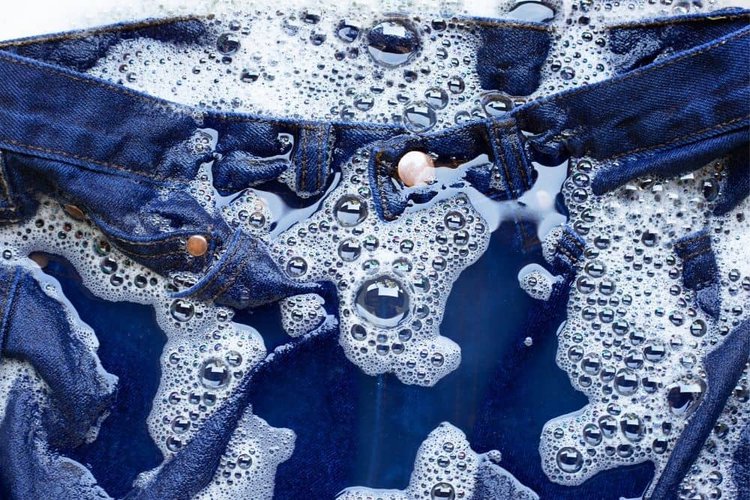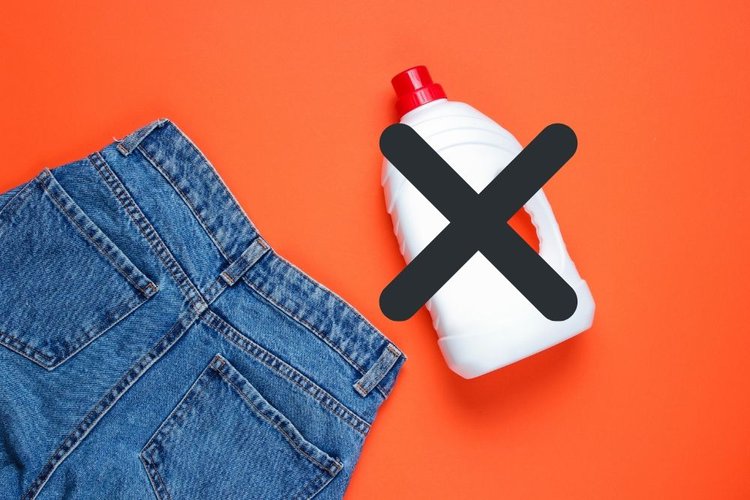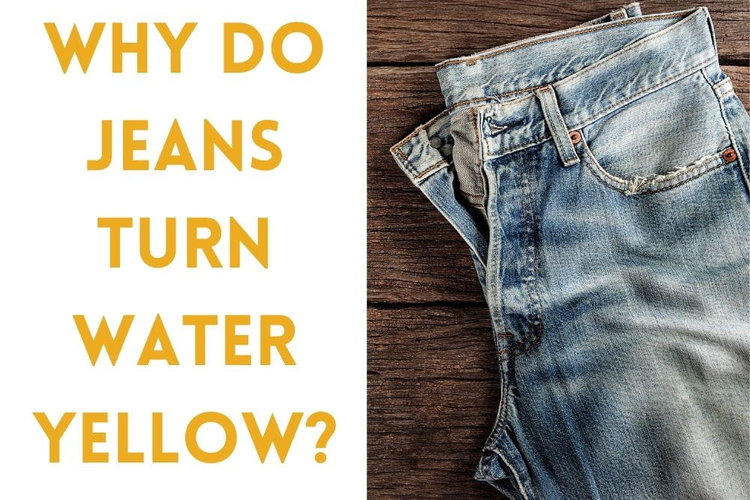A few decades ago, when my father was still a factory worker in a Michigan car factory, He wears jeans quite often and felt quite comfortable with this.
My father said that at the time, jeans were dyed with traditional indigo dye, which allowed most jeans to be the iconic indigo blue. This doesn’t mean you couldn’t find colored jeans in the 19th century, but they were less common.
But it’s very less likely that jeans at that time turn water yellow when washed. This is because the chemical composition of traditional dyes is different from today’s dyeing technology.
I’ve worn jeans for almost 30 years of my life, and I would admit that jeans in this day and age are by far improved in terms of technology and dyeing.
This results in the fact that people can now opt for hundreds of jean shades and jean fabrics to go with them, especially some super bright colors such as yellow, green, violet, or even red.
However, I guess you have been surprised to see your jeans turn water yellow when you wash them for the very first time, even though the jeans have not applied this tone before.
So what caused this thing? Does this lead to negative impacts?
Check it out below!
Quick Navigation
Why do jeans turn water yellow?
Today, most high-end jeans do not turn water yellow when washed. This is because they can be pre-washed before being shipped, reducing chemical residue in the fabric structure.
But if your jeans produce yellow water from the very first wash, it could be due to one of the following reasons:
Chemical sulfur
As mentioned above, the traditional denim fabric dye is an indigo dye, extracted from the leaves of the Indigofera tinctoria, or Indigo plant. This is also the most original color of jeans since they are present in our lives.
However, this dyeing chemical is not really optimal in terms of efficiency. The thing is, dyeing jeans requires a large number of chemicals due to the slow coloring ability of indigo dye.

Therefore, today, sulfur jeans dye has been born as a more advanced alternative. While indigo dyes may require 12–15 buckets to dye, sulfur dyes only need 3-5 buckets to yield the same results.
Besides, dyeing jeans with sulfur dye also saves water and electricity usage. Therefore, most jeans factories today use this dye.
Sulfur at room temperature will have a lemon-yellow color. Although they have been added with other ingredients to modify and color the denim fabric, they still have the ability to yellow when washed with water.
Therefore, the biggest reason your jeans turn water yellow is that they are dyed with sulfur dye, while jeans dyed with indigo dye will not produce yellow water.
If your jeans are colored other than yellow or a variation of yellow and still produce yellow water, chances are they are dyed with sulfur dye.
Jeans are dyed yellow
Some jeans that are dyed yellow or tan when washed in hot water or with soap are likely to fade, creating yellow water.
Some low-quality jeans even produce a deep yellow dye, as if you were dying them. These jeans are also easy to fade over time.
However, the condition may improve with subsequent washes if there are fewer yellow shades in the washing water. In addition, some jeans in super bold colors are also capable of giving off yellow water when washed.

This is because the sulfur chemical content during color treatment is higher than that of light colors, increasing the risk of sulfur retention in the fabric.
Keep in mind that washing jeans in bold colors at a higher temperature is more likely to cause them to fade and produce yellow water.
Yellow stains
If your jeans don’t turn yellow in the first wash but all of a sudden you realize the water is turning yellow, this could be because your jeans have some special yellowing chemicals like turmeric, peanut butter, yellow mustard, coffee or tea.

I used to work in a traditional turmeric factory in China for several years, and I wear indigo jeans every time I go to work. I didn’t see any discernible yellow on my pants during my work.
But every time I wash my jeans, the washing water turns pretty red and yellow, like turmeric. Jeans have the ability to hide stains quite well because of their sturdy construction and rugged surface, especially when the jeans are dyed dark or in dark indigo blue.
However, you will not know what stains are hiding inside the fabric and just waiting to fade when exposed to water.
Some parts of jeans come with bold yellow shades
Some jeans have an interesting make-up trouser tag that is dyed a bold yellow.
The jeans tag usually does not use jeans fabric as its form. They are made of synthetic fabrics that have a high color retention capacity.
However, if jeans’ tags are dyed a bold yellow and washed in warm, soapy water, the chances are they tend to turn the water yellow noticeably.
To test this, you can wet the jeans gradually from bottom to top.
If the hem of jeans turns water yellow, then the main cause is the jeans’ fabric and dyes.
If jean fabrics don’t turn water yellow but there’s still yellow water after washing, check the tags right away. You’ll probably find some clues there.
If the tags are the main cause of this problem, the yellow water can add some uneven colored stains to the remaining parts of the jeans.
Be aware of this! You will probably need to dry clean the jeans and their tags to make sure there are no unusual discolorations on the jeans.
Re-dye the jeans at home
Some people choose to re-dye their jeans at home to save money or simply because they love their faded jeans and have not found a better replacement. However, dyeing jeans also requires some special techniques.
Besides, the jeans factories also have machines to process the dye evenly and to the best of their satisfaction.

This is a disadvantage for those who want to dye their jeans at home. You can make the mistake of dyeing a pair of jeans with too much dye.
Due to a large amount of sulfur in every jean’s fiber, your jeans can also turn water yellow.
Your jeans are low quality
Some lines of polyester jeans are sewn from old jeans, called “recycled jeans.” They are extremely low quality and not breathable to wear.
Due to the disparity between colors when stitching different pieces of jeans together, recycled jeans require dyeing with a larger amount of chemicals than usual to even out the color.
You won’t usually find recycled jeans in pale colors; they’re usually bold indigo. The high amount of dye in the fabric structure is also the cause of turning water yellow when washing.

How to prevent jeans turning water yellow?
Aside from the reason for the dye content in the fabric of jeans that turns water yellow, the way you wash the jeans can also encourage or discourage this result.
No surprise, colored jeans are sensitive to heat and soap, since many have warned you not to wash them with soap or washing detergent.
To prevent jeans from fading and turning watery yellow, you can refer to the following ways:
Wash jeans with cold water
Cold water is jeans’ best friend. They do not cause the jeans’ fabric to shrink suddenly, and they do not affect the structure of the fabric dye, causing color fading. In any case, washing jeans in cold water is best.
Chemically, dyes (including sulfur) are not capable of transformation at room temperature. They are also generally insoluble in water at room temperature.

That’s why dyeing jeans always requires a high-temperature dye solution. High heat will soften the fabric and dye, causing fading in water.
This method can be very effective for keeping the color of jeans, but it may not be effective at washing stubborn stains off jeans. Check out the healthy cleaning methods for jeans right below.
Stay away from all kinds of washing detergent
In addition to hot water, common laundry detergents also have a significant impact on turning jeans’ water yellow.
You may not realize this all too well because the pulsating white soapy foam prevents you from seeing the yellow water.
The higher the concentration of the detergent solution, the faster the color of jeans fades.

I have never liked detergent power because I find it to be the most powerful detergent in bleaching more than detergent liquids do.
Besides, washing jeans regularly with soap or detergent also makes the fabric dry, brittle, and more prone to breakage.
Keep in mind that this will happen faster for 100% cotton jeans than for jeans with some synthetic fabrics in their construction.
If you have bold-colored jeans, you will soon realize you have made the worst decision of your life when washing your jeans with any kind of washing detergent.
To clean the jeans properly, you can mix some household cleaning solutions with mid-acids such as water and apple vinegar. This gently washes away sour smells and stubborn stains.
Frozen jeans before washing
This is a pretty effective method for keeping bold colored jeans looking good over time.
Freezing jeans before washing creates a favorable environment for the dye to adhere to the fabric more firmly and longer.

You may be wondering if the opposite result will happen when you defrost your jeans or wash them in warm water afterward.
Well, the answer is that jeans will still produce yellow water when washed in high heat, but you will notice they have faded less color than when not frozen before.
You just need to wrap your jeans in a sealed nylon bag and close it tightly. Leave the bag in the fridge for about 3 days. I highly recommend you never wash jeans with either hot or warm water after this freezing process.
Turn the jeans inside out when washing
This is the simplest way for you to avoid turning your jeans yellow when washing them.
You may notice that the majority of the underside of the jeans has not been dyed, as the colors are mostly visible on the top of the fabrics.
Don’t rush to judge this!
Manufacturers are protecting your skin. If they dye the underside of your jeans, your sweat contains moisture, and your salt will dissolve some of the dye.
Your skin may have some colored marks as well as develop some sort of itchiness due to chemical allergies.
Be thankful that jeans are not dyed on the underside of the material.
Therefore, you can turn the inside out of the jeans before washing to prevent water from coming into contact with the dyed side right away.
This can prevent the jeans’ dye from fading and turn the water yellow unexpectedly.
No machine wash
It’s no wonder why; the super strong rotation of the washing machine directly affects the fabric structure and the dye structure.
This is like when centrifuging a certain solution, the different layers contained in the solution will be separated later.

The strong spinning force from the washing machine can also cause jeans to fade and turn water yellow in this way.
Be aware if this ever happens to your jeans. You may need to wash jeans separately from other white clothing if you don’t want the bright clothes to be soaked in penetratingly colored stains afterward.
Before you leave
Personally, I don’t think jeans turning water yellow is a good sign.
The cause of the problem probably falls into some of the reasons above, but chances are your jeans are made poorly with an improper dyeing process and management.
Don’t hesitate to check this issue with the manufacturer if this brings up some dissatisfaction with your wearing experience.
Hi, I’m Grace Alision, a fashion lover with a passion for helping women feel confident and beautiful through their style choices. I created this website to share my love for wedding guest dresses and, in the future, to explore concert outfit inspiration. Dresses have always been my favorite way to express elegance and individuality, and I’m here to make finding the perfect outfit fun and easy. When I’m not working on outfit ideas, I love discovering new trends and connecting with others who share my love for fashion.

